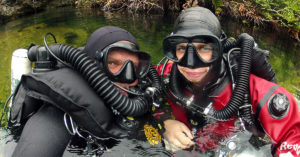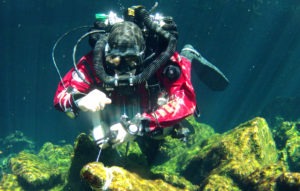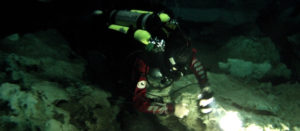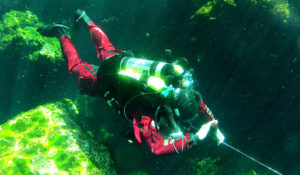Recently I taught a CCR cave diver program and as we went diving in the local caves here in the Riviera Maya it came to me again how much cave diving you can do on a Rebreather if you just don’t get in and out of the cave in a hurry.
I still remember when going o/c cave diving and the only thing I was thinking of was going in and out. The thought of visiting side passages or just pause for 5 minutes to admire the cave passages was a strange thought indeed.
Since diving on Rebreathers in caves (1997) and teaching it too I come to spend way more time in the cave without the need of long or fast penetration. As long as you stay within your bailout (o/c bailout that is, I am not touching the subject of CCR bailout here) range (bailout range calculation and bailout concepts will be dealt with in a separate article) you can spend the entire scrubber duration, oxygen duration or diluent duration (whatever comes first) on location within the bailout range.
I used to think of the bailout range as a umbrella but changed my way to come to think of it as a bubble as the entrance is in the center and the bubble wall is the edge of my bailout range I can spend the consumable duration within this bubble.
Here in Mexico we are somewhat lucky that our caves are very complex and have multiple passages and entrance that go all over the place. Good understanding of navigation and how to mark your way out is a must and given, a craft well practiced within our complex caves.
When you pre-calculate and verify your bailo0ut range by calculation of RMV, depth and distance traveled by the minute you come to a x distance, hence your bailout range. This bailout range needs to be verified by actual o/c bailouts during a variety of scenarios to see if the numbers match up when underwater. It’s easy to calculate all day sitting in the dry and breathe air all day, it’s a different issue being on o/c bailout in the cave.
Once we have established a close to reality bailout range and factor in high breathing rate factors such as high stress or elevated co2 we are getting to what we want to take with us into the cave and as we are limited to what we can take with us (not so much fun to take 4 bailout tanks with us) we have a limited bailout range.
Recently I did a CCR cave dive with my student Osmo from Finland and we gave us a bailout range of 24 minutes with RMV, tank size and swim speed. Not much you might think but we did a 3 hour cave dive on it. Yup. 3 hours.
The difference in complex CCR cave diving is that as you go in you take way points – time points at jump off locations and as you go in along the primary line you reach your bailout range calculated in time and distance. As you travel back along the line, and you have plenty of time with a 6 hour scrubber and 6 hour oxygen and even more diluent, you travel slowly, having a good look around. As you come to your jump off point where you have taken the time it takes to get out from this point you can add the time it takes from here to come to your bailout range again just on a different line, in a different cave passage.
On that particular dive not to long ago we did 6 jumps on the way out never exceeding our bailout range on any of the jumps of lines we went on. We did see a large chunk of cave on a single tank we would not have been able to see on a o/c cave dive. What a great dive that was.
The things you need to do such a dive is a Rebreather, a good grasp on bailout calculation and procedure, a good grasp on complex navigation and not to forget a complex cave that is nice to look at.
I would like to congratulate Osmo to the passing of his CCR cave diver course. Osmo was diving on a CCR Pelagian Rebreather while I was diving on a CCR Megalodon Rebreather.
Awesome diving and I can’t wait to get it going again!
Matt




